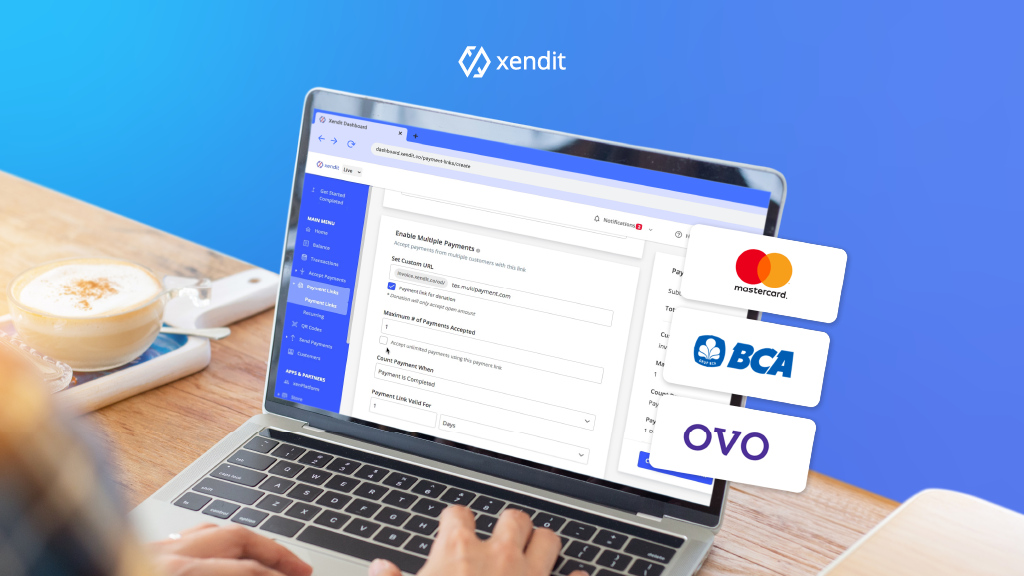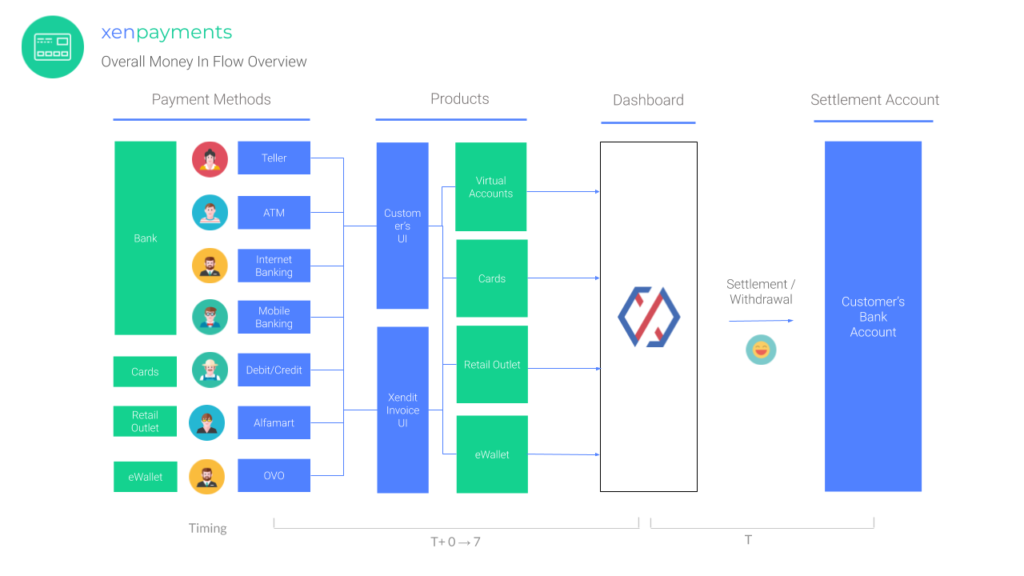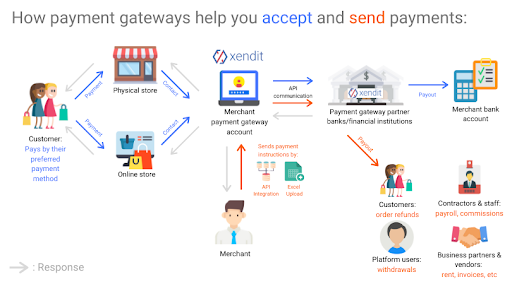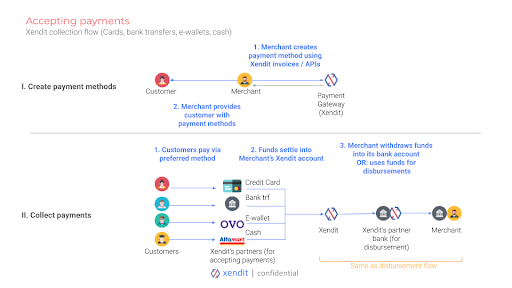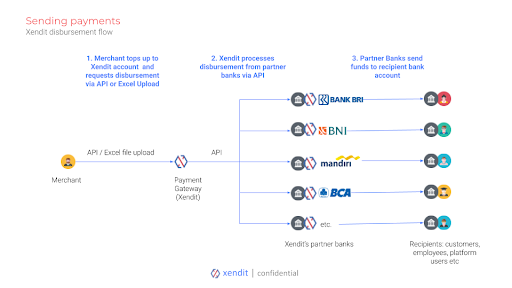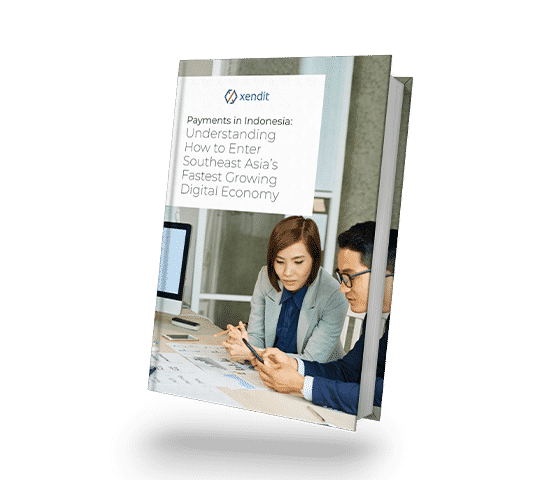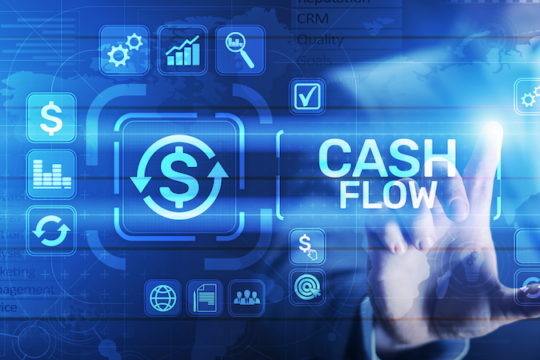With the rise of digital commerce, more and more of us are buying goods and services online. It is estimated that from now through 2027, online payment transactions will continue to increase by an annual growth rate of more than 12%.
As we adapt to an increasingly cashless world, many of our payment transactions are performed digitally. This calls for efficient and secure payment service providers to help facilitate such transactions. A payment gateway enables online transactions and ensures that sensitive data is being protected. It helps simplify the way we make payments and increase efficiency for both businesses and consumers alike.
What is a payment gateway?
A payment gateway is a service that facilitates online transactions to occur between businesses and their customers. It is the secure infrastructure that authorizes the transfer of funds conveniently from your customers’ banks/e-wallets to your business.
How do payment gateways work?
Payment gateways help merchants accept, process, and send payments. When a customer makes a purchase, the payment gateway encrypts their information and sends it to the respective financial institutions. It serves as a middleman between the seller and the buyer that handles all the transactions and ensures that both parties are protected.
This process is much more secure than processing payments manually, and it also eliminates the need for businesses to store any customer information on their own servers.
Accepting money
Payment gateways transmit AND authorize transactions, while payment processors merely transmit the payments. Behind the scenes of moving money from buyer to seller, a payment gateway is hard at work ensuring that each transaction runs quickly, smoothly, and securely, typically by:
- Encryption: Payment gateways encrypt sensitive data that is sent between the customer’s browser, the retailer’s server and the bank. This makes the data exclusively encoded for private use between the buyer and seller, keeping the buyer and seller’s financial data secure. Payment gateways that are Payment Card Industry Data Security Standard (PCI DSS) compliant remove the need to manage expensive hardware and software to store sensitive payment details (i.e. card information).
- Request: The payment processor receives an authorization request from a financial institution or credit card company to proceed/not to proceed with the transaction and sends the response to the payment gateway.
- Fulfillment: The payment gateway will authorize transactions to proceed to the next interface (either on the seller’s or payment gateway’s user interface).
Payment gateways make timely bank transfers possible by partnering with multiple banks to set up virtual accounts for your business. Transactions can then be easily managed and monitored on the payment gateway’s dashboard.
It is important to ensure that transactions occur on time. Payment gateways normally reduce the amount of time taken to move funds between buyer and seller, and also have the ability to reconcile payments.
Sending money
Beyond helping businesses accept payments, payment gateways can help businesses send money out too; enabling businesses to transfer money to their business partners, users, and staff at scale.
Payment gateways can set up direct integrations with multiple payment processors, such as banks, to enable faster and more reliable payouts.
For example, Xendit has made automated and timely transfers possible by integrating directly with most of the major banks in Indonesia. Intra-bank transactions go over the bank’s internal ledger, while interbank transfers go through an interbank switcher network before arriving at the recipient bank. Upon receiving a transfer request, our system automatically processes the transfer via the optimal bank channel based on what’s available and fastest for that payout amount and bank destination. This process is simplified in the diagram below:
How can payment gateways help my business?
If you own a business that requires you to receive and send payments, you’d likely know how important it is to provide the best customer service. Convenience, reliability, and speed are all important aspects of the customer experience that can be improved with the right payment experience.
Payment gateways definitely increase the convenience of accepting and sending payments as they help reduce manual efforts of having to reconcile payments. When your customers are able to make payments in the fastest and easiest way, you would likely achieve higher checkout rates.
By utilizing payment gateways that work with many payment options, you can make it simple for your consumers to select the solution that best suits them. Payment gateways are frequently used by both online and offline businesses to execute bank transactions via virtual accounts, credit cards, and e-Wallet payments. Your company no longer needs to negotiate with different banks and other financial organizations if you engage a reliable payment gateway.
Additional features that payment gateways may provide include real-time notifications, automatic payment confirmations, and data reconciliation.
Benefits of a payment gateway
- Increased security
One of the key benefits of a payment gateway is that it increases security for both the customer and the business. All data transferred through the payment gateway is encrypted, meaning that it’s highly secure and can’t be accessed by anyone other than the business and the customer. This helps to protect both parties from credit card fraud and other security threats. - Cost saving
A payment gateway can help reduce the cost of processing payments for your business. By taking advantage of a payment gateway’s lower transaction fees, you can save money on each purchase made through your website. There are usually no set-up fees or monthly charges when engaging a payment gateway, and you can start processing payments in minutes. In addition, a payment gateway can help you streamline your checkout process. By accepting payments through your website, you can reduce the amount of time and money that is spent processing payments manually. This can help you focus on growing your business instead of wasting time on administrative tasks. - Greater flexibility
A payment gateway provides your business with greater flexibility when it comes to accepting payments. It allows you to accept payments from a wide range of customers, in a variety of ways. For example, payment gateways usually integrate with different local banks, e-wallets, and international payment options such as MasterCard and Visa. This means that you can continue to grow your business by accepting payments from new customers, in new ways. - Enhanced customer experience
Payment gateways can help improve your customer experience. It allows you to offer your customers more options when it comes to making payments, including virtual accounts, credit cards, bank accounts, and many more. This means that you most likely have their favorite payment methods available as an option, and they can pay for their purchases quickly and easily, without any hassle. - Increased sales
As your business grows, you’re going to want to find ways to scale it. One of the best ways to do that is by using a payment gateway. A payment gateway will allow you to accept payments from customers anywhere in the world, without having to worry about fraud or chargebacks. In addition, a payment gateway can help reduce cart abandonment rates. When customers see that they can pay with their preferred method, they are more likely to complete the purchase. This can help increase your sales and revenue. - Ease of integration
It is easy to integrate payment gateways into your website or e-commerce platform. All you need is to copy and paste an API (Application Programming Interface) code and you’re ready to go. A customer service agent will also be there to guide you through the process if you face any difficulties. This makes it a quick and easy way to start processing payments. - Reliable support
One of the best things about a payment gateway is the excellent customer service it provides. This means that if you ever have a problem with a transaction, you can get help immediately. Whether you need assistance with setting up your account or resolving a dispute, the customer service team is there to help. Some customer support teams can also provide advice on the best payment methods for your business.
What to look for when choosing a payment gateway?
The best payment gateways are known to be fast, secure, simple to use, and supported by a fantastic customer support team. Choose a payment gateway that has the following characteristics:
- Secure
Your customers will be sharing their financial information when making transactions and therefore it is imperative that the payment gateway you select has a good track record and has protection against fraud. The payment gateway you are considering should have:- PCI-DSS
Payment Card Industry Data Security Standard (PCI-DSS) is an information security standard to handle branded credit cards from the major card schemes.
- AES-256
Advanced Encryption Standard (AES-256) uses a 256-bit key length to encrypt sensitive data. This level of encryption is highly secure and used most often for communications with banks to maintain the privacy and security of customers.
- ISO 27001
ISO 27001 is an internationally recognized auditable standard. When used, organizations are able to manage the security of financial information, and other sensitive information.
- TUV certification
TUV stands for (Technischer Überwachungsverein, English translation: Technical Inspection Association). Having a TUV certification is an endorsement that the company’s product is safe, sustainable, and of good quality.
The best payment gateways also deploy machine-learning-powered technologies for fraud detection, and can even preemptively block high-risk transactions. Simple
Using a payment gateway that integrates with multiple banks and other payment options makes for easy and fast transactions that ensure smooth customer experiences. You won’t have to waste time navigating through complicated steps.Your payment gateway should have a unified web-based dashboard for you to do the following easily:
– View all transactions
– Set up all your payment methods in one place
– Access and download detailed financial reports, including line-by-line reconciliationService
A lot can go wrong, and when things go south, you’ll need to solve problems quickly when dealing with sensitive information like your company or customer’s financial details. Test the customer service of a payment gateway by sending a customer support email. When you have a good customer service team on standby, you can be sure that your concerns will be addressed promptly and your trust in the provider will also be strengthened.With always-on digital transactions nowadays, problems can come at any time. To resolve your issues quickly, make sure that the payment gateway you choose has a support team on standby 365 days a year–if not 24/7.
Speed
Timely payments are key in building trust with your customers and partners. Therefore, it’s important to pick a payment gateway which has good uptimes and fast settlement speeds. It should also provide you with tools to automate and scale your processes, be it APIs or bulk transfer tools to avoid time-consuming manual processes.Global
Online purchases and payments today transcend boundaries. An online shopper from Singapore can purchase products from a Canadian site. Having a payment gateway that allows you to accept different currencies and that already has experience serving businesses globally can help you scale your business more easily.Affordable
Take note of the fees associated with using the payment gateway to ensure that the cost fits your company’s budget. Fees include contract, subscription, and per-transaction fees. Some payment gateways offer pay-as-you-go payment schemes which would be great for small businesses that are just starting out.Before you commit to a payment gateway, it’s important to make sure there are no hidden fees (such as admin fees, set-up fees, etc.) to avoid any nasty surprises.
Speed to innovate
Customer and business needs change quickly, so it is important to find an innovative payment gateway that is constantly striving to build the solutions and features you need to make your business thrive. For example, your business may require you to send money to different entities such as vendors, clients, and employees. A payment gateway that is able to automate such transactions would help to save you time and money.Features
Payment gateways may offer additional services that may help your business save operational costs (report generation, payment management and monitoring, etc.). Note if the payment gateway has the functionality to accept international cards, provide fraud detection and 3-D Secure optionality. Certain payment gateways also provide custom invoice billing services and automated notifications.Scalability
Different payment gateways are written by different developers on different stacks. When planning to scale your business quickly, it is important to understand if your payment gateway can support the scale that your business wants to grow to.Are the processes automated? How much time would it take for you to make 10 times the volume of transactions you have today with the same payment gateway? One consideration is also whether you are able to make bulk payments through a simple API integration or excel file upload. This would help your business scale without adding any additional operational resources.
Reliability
Find a payment gateway that has a good track record and works well all the time. Take a look at the portfolio of other customers they serve to get a sense of who trusts their service. Testimonials from customers are also good indicators of how reliable and trustworthy a payment provider is. If their customer service team is able to reply promptly and solve your queries efficiently, you can be sure to rely on their services.
Xendit, the leading payment gateway in Indonesia, the Philippines, and SEA
Xendit is a leading financial technology company that provides payment solutions for businesses in Indonesia, the Philippines, and Southeast Asia. Whether you are an SME, a startup, or an enterprise, Xendit has the right solution for your business:
- Payment links: When your customer makes an order, you can generate a payment link via the payment gateway’s dashboard. You can share this link with your customer to direct them to the payment gateway’s payment page to complete the transaction. This is the easiest way for your business to get started. However, it requires some manual workflows and offers limited customization. This also adds an extra step for the customer.
- API integration: Build custom checkout or disbursement flows by connecting to the payment gateway’s APIs. Customers can initiate the transaction on your company’s site and do not need to be redirected to a third-party site. The payment is processed on the payment gateway’s back end. This requires some development resources to integrate, but your business will have control over your customers’ entire payment journey.
- Third party sites (Shopify, WooCommerce, Opencart, Magento, and more): If you have built your store on one of the popular e-commerce platforms, you can integrate Xendit payment gateway easily and enjoy our ready-to-use checkout UI on your website. Having checkout on your company’s website will give you more control over your customer’s experience, while the payment gateway takes care of the payment processing. The payment gateway will handle payment instruction, payment UX flow, payment number or card processing, and the payment confirmation itself, so you do not need to change your order status manually when the order is paid by your end customer.
Xendit enables businesses to accept payments from direct debit, virtual accounts, credit and debit cards, e-wallets, retail outlets, and online installments. Having Xendit as your reliable payment gateway partner gives you control over payment transactions and ensures that your business is able to operate efficiently and scale effectively. Contact us today or sign up for a free account today!



